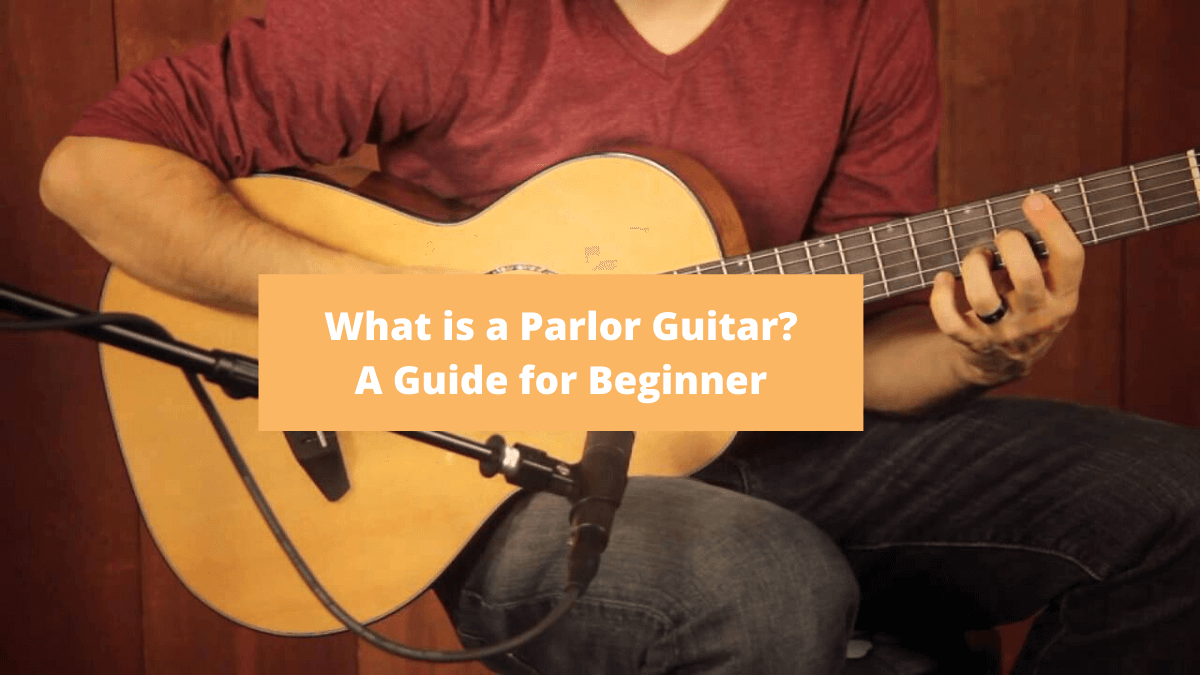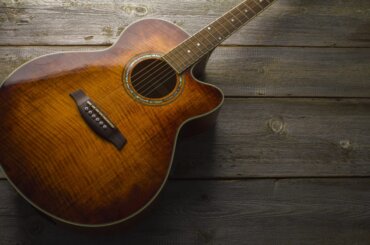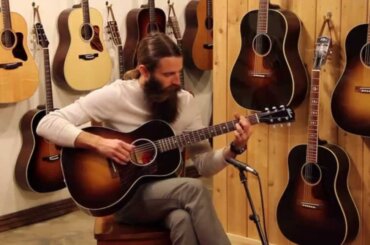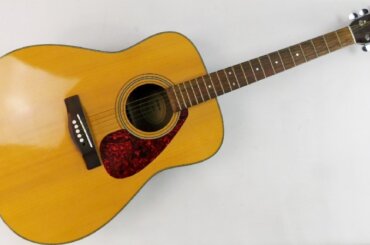Acoustic Guitars are available in a variety of different sizes. They are available in a dreadnaught size and in a Jumbo style too. But if there is a guitar which fits exactly in the middle of the biggest type of acoustic guitar and the smallest type, it is the parlor. It’s time to break the misconception that some people have about the size of Parlor guitars. They aren’t the smallest type of guitars available in the market. Born in the late 19th century, parlor guitars were usually popular for folk and blues music for more than a hundred years. Played by every type of player, Parlor has an immense amount of popularity in beginners. It might be because of the cheaper rate at which they are available than dreadnaughts or Jumbo guitars.
In 2013, a Canadian astronaut Chris Hadfield made history by performing Space Oddity on a parlor guitar. The video clip was captured live from the International Space Station and the video went viral. Larrivée, the manufacturer of that parlor guitar got the best publicity of all time. Let’s dive into the history of Parlor guitars to know how this guitar came into existence.
What is a Parlor Guitar? – A Brief History
Parlor guitar is a small acoustic guitar that came to prominence between the years 1800 and 1900. Unlike a classical guitar, it has steel strings. Another point that makes a Parlor Guitar unique is that it came out of a European design instead of the traditional Spanish design.
Many people believe that the parlor guitar’s small size in to please the women players and young ones. The truth is that the guitars of those times were much smaller than today’s guitars. This is possibly due to the evolution from the similarly sized lute. It was not until 1916 that the dreadnought size surfaced.
The popularity of the Parlor guitar continued to grow in the United States and become a large part of America. Because the study of music was only for masters, the few talented middle-class artists usually played for their patrons.
Parlor Guitar got its name in America as the guitar for a common person. This new populist view of music allowed both men and women to study, play, and teach the guitar. It was also a sort of freedom of teaching and performing for women of that time.
It is about the music and sound of the instrument. Parlor Guitar’s name links with a parlor music tradition that isn’t formal folk music. However, Jeffrey Noonan rails against this idea arguing that the European heritage of parlor music and formal study propelled the guitar to its success. The parlor tradition was not only studied in America but also was tremendously influential in American society. Parlor Musicians studied and performed at various skill levels. Even children were taught and encouraged to play and sing along with the music.
Small Classical Guitars Versus Nylon String Parlor Guitars
Small classical guitars are scaled-down versions of their standard-sized counterparts. For example, if there is a company that has made some Guitar model X. And that guitar model X is too baggy for players of a certain age to carry. The same company comes up with a smaller version of this model X, to satisfy the specific age group that finds the guitar too baggy to carry. Guitars that follow the same shape, build and style with the only difference being the smaller measurements are smaller guitars. The final result is a tone similar to standard size classical guitars but lesser sound projection. 7/8 and 3/4 classical guitars fall under this category and are popular for beginners and serious students of the instrument.
They aren’t made following the shape of any other available dreadnaught or Jumbo model. They follow the compact design of “parlor” instruments from the early 1900s. These are compact instruments that have more pronounced middle frequencies and are more comfortable to carry around. The ideal is to make grab-and-go instruments that can be left on the couch or on a stand. Regardless of your preference, you will find a Parlor that suits your budget and style.
Parlor guitars are known to have a boxy tone. It is this tone that makes Parlor Guitar usable in various genres of music that demands more resonance. Blues and Jazz music of the 80s and 90s are an example of genres that require such a tone.
Classical guitars are known to have a sharper tone than Parlor Guitars do. They do not necessarily have a lesser resonating sound than a Parlor Guitar. Country music, retro vintage, rock, and roll are some of the genres that Classical guitars are more favored.
Notable Musicians Who’ve Used Parlor Guitars
You have already understood: What is a parlor guitar? Its time to talk about those who admire the construction.
Although, arguably a Parlor Guitar is not as mainstream as a dreadnaught guitar. They have a history and continue to be seen on some of the biggest stages and recordings.
- The Spanish Fandango by Henry Worrall is one of the few parlor guitar songs that survived to this modern age. The song is still played by many renowned guitarists worldwide.
- Robert Johnson can arguably be titled as “the most popular guitarist who wielded a parlor-style guitar.” Ironically, he wasn’t commercially successful in his lifetime. His playing style is known to have influence popular guitarists like Eric Clapton, Stevie Ray Vaughn, John Mayer and many more. In his popular song Crossroad, he has played Parlor Guitar throughout the song.
- American folk singer Joan Baez opted to use a parlor guitar in a time when dreadnoughts were mainstream. She went on to become one of the most popular female folk singers of her time. She lived with five and a half decades worth of performances and 30 albums. Whether it was original songs or covers, her parlor guitar provided a unique tone that perfectly matched her voice.
- Forwarding to the 21st century, pop artists like Ed Sheeran, Taylor Swift, and John Mayer have used Parlor Guitars. John Mayer made the switch to parlor guitars from his usual dreadnoughts and OMs. He put his namesake parlor guitar to good use by writing and performing many of his new songs on them. The blues version of Something like Olivia by John Mayer showcases awesome and well-built parlor guitar performing blues band setting.
What is a Parlor Guitar? – Things to Look for
A hardwood neck is the first thing look to out for in a parlor guitar. The neck of a Parlor needs to be very straight for the best results. The body style will keep on changing forever from model to model. So if you are after a parlor inspired model, then seek a guitar with its iconic proportions.
Ideally, you want a solid body top for better sound and projection. The frets should be laid accurately and raised enough to play intuitively. Also, they should not be so much so that they become detrimental to smooth fingering. One should opt for an adjustable truss rod where available so that you can adjust the action to suit ones playing.
One thing that’s critical about Parlor Guitar is its tuning machinery. The strings need their tension to be kept, though they will stretch over time. The neck wood will warm and cool from time to time, so they may need the occasional adjustment. For this reason, you want tuners with gears that feature fine increments so that you can tune more accurately.
Metal gears help to hold the string more tightly. Moreover, they also ensure that the string is firm in place. Once they have settled in, a good set of tuning heads should keep pretty strict pitch. Hopefully, they don’t get knocked about changing dramatically without quite a bit of effort. As with any instrument, this boils down to the manufacturing quality itself. The quality of the materials used, and the budget you have in mind play an important role.
Usual Construction of a Parlor Guitar:
Understand the construction, you can find out what is a parlor guitar and how is it different from others?
The top choice for the face/top wood of parlor guitars has been solid Sitka spruce. It’s rated on appearance and on how close the grain is together. A few manufacturers have experimented with solid mahogany tops, which aren’t as loud. These provide the look of a classical guitar. Even though the cedar-topped parlor has steel strings. The expectation is that you’ll fingerpick them to get the best use of the unusually rich tone. If you are a keen observer of guitars, it may come to your notice that cedar-topped parlor guitars have no pick-guard. That lets the cedar vibrate more freely, and actual guitarists almost never really need the pickguard anyway.
Spanish-style Classical guitars were Parlor guitars in the first place. These guitars tend to have the 12th fret right where the neck joins the body. Usually, Dreadnought guitars have the joint on 14th fret, whereas Parlor guitars often catch up in the middle. The 14-fret version should be longer and possibly have a longer scale length.
Most of the recent designed parlor guitars have necks about the same width (1 11/16″ to 1 3/4″ – about 43mm to 44mm). A point to note here is that parlor guitars were based on Classical predecessors. So you’ll occasionally find a parlor guitar with a usually wide neck.
Lead guitarists love to playing way up the neck. However, they also feel frustrating sometimes to reach the fifteenth fret on a parlor guitar. Because after that they can’t go any higher. It is because of this reason that manufacturers have invented the cutaway option. This is to give those players better access to the higher frets. It does affect the tone even a little when the guitar is not plugged in.
Pros and Cons of a Parlor Guitar:
Pros
- What makes the parlor guitar comfortable is its design which is relatively lightweight and compact. This means you can take it with you and play anywhere. The action of these guitars is low, and it’s easier to wrap your arms around its body. You probably won’t need to make a lot of tweaks.
- As for the construction, it usually has a small body that features a solid design. Normally a cedar top and mahogany back and sides. The fretboard and the headstock are rosewood with abalone inlays. Besides the neck, the body has a stunning gloss finish. The sound produced is nothing short of impressive. The tones are warm, clean, bright, and well-defined.
- The sound is a nod to classical acoustic guitars. The tones are well-rounded compared to vintage.
Cons
- Although these small-bodied guitars are a great mid-range option, there are more premium guitars that offer better tone results. If you’re switching from a larger guitar, you’ll notice that the tone isn’t as full as your previous guitar.
- The only that players often have with parlor guitars are about the tuning pegs. With regular use, pegs, either become too stiff or too loose. You would need to either tighten or oil them. If you have a guitar that is used regularly, this becomes much of a headache.
- Most of the Parlor guitar doesn’t feature a pre-amp. They only have a passive pickup, which means the amp will have to do all the tone shaping. This is frustrating because if you’re gigging, you’d need an onboard EQ controls which they lack.
The Conclusion
With all the information above, you might understand: What is a parlor guitar? A Parlor Guitar is easier for smaller students to hold than dreadnought or jumbo guitars. If a student is very young, the guitar can be equipped temporarily with nylon strings. Parlor guitar consumes less space compared to a dreadnought or jumbo. Given the same quality, a parlor guitar does not sound as loud as dreadnought or jumbo guitars. In some circles, a parlor guitar generally doesn’t generally have the appeal as a dreadnought does. So, choose as you please with all the details handy.





